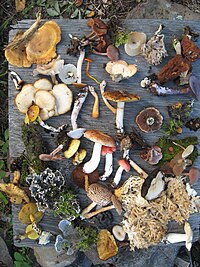
What lies beneath? Fungal diversity at the bottom of Lake Michigan and Lake Superior.
Sign Up to like & getrecommendations! Published in 2018 at "Journal of Great Lakes research"
DOI: 10.1016/j.jglr.2018.01.001
Abstract: Fungi are phylogenetically diverse organisms found in nearly every environment as key contributors to the processes of nutrient cycling and decomposition. To date, most fungal diversity has been documented from terrestrial habitats leaving aquatic habitats… read more here.
Keywords: lake michigan; diversity; fungal diversity; lake superior ... See more keywords

Major shift in the phenology of crustacean biomass in western Lake Superior associated with temperature anomaly
Sign Up to like & getrecommendations! Published in 2018 at "Journal of Great Lakes Research"
DOI: 10.1016/j.jglr.2018.05.005
Abstract: Abstract Variable weather patterns during the early months of 2014 and 2015 resulted in differences between years in spring and summer surface water temperatures in the offshore areas of western Lake Superior. Zooplankton were collected… read more here.
Keywords: western lake; zooplankton biomass; biomass; lake superior ... See more keywords

Contemporary abundance patterns of Cyclotella sensu lato diatom taxa in Lake Superior: Assessing responses to physical and chemical gradients and potential links to climate change
Sign Up to like & getrecommendations! Published in 2019 at "Journal of Great Lakes Research"
DOI: 10.1016/j.jglr.2018.11.014
Abstract: Abstract Many studies attribute shifts in relative abundances of Cyclotella sensu lato diatom taxa in freshwater lakes over the past 150 years to climate change. Although abundances of several of these taxa have also changed in… read more here.
Keywords: lake superior; cyclotella sensu; sensu lato;

Dreissena veligers in western Lake Superior - inference from new low-density detection.
Sign Up to like & getrecommendations! Published in 2019 at "Journal of Great Lakes research"
DOI: 10.1016/j.jglr.2019.03.013
Abstract: The notion that Lake Superior proper is inhospitable to dreissenid mussel survival has been challenged by recent finds on shipwrecks and rocky reefs in the Apostle Islands region. Motivated by concerns surrounding these finds, we… read more here.
Keywords: dreissena veligers; lake superior; dreissena; low density ... See more keywords

A lake-wide approach for large lake zooplankton monitoring: Results from the 2006-2016 Lake Superior Cooperative Science and Monitoring Initiative surveys.
Sign Up to like & getrecommendations! Published in 2020 at "Journal of Great Lakes research"
DOI: 10.1016/j.jglr.2020.05.005
Abstract: Whole-lake surveys of Lake Superior were completed during late summer in 2006, 2011, and 2016 to assess lower food web conditions under the Cooperative Science and Monitoring Initiative (CSMI). These surveys used a spatially stratified… read more here.
Keywords: zooplankton; science monitoring; lake superior; monitoring ... See more keywords

Dietary Niche and Growth Rate of the Nonnative Tubenose Goby (Proterorhinus semilunaris) in the Lake Superior Basin.
Sign Up to like & getrecommendations! Published in 2020 at "Journal of Great Lakes research"
DOI: 10.1016/j.jglr.2020.07.014
Abstract: The tubenose goby (Proterorhinus semilunaris) entered the Great Lakes in the 1990s via ballast water, but remains poorly studied within North America, making it difficult to predict its effects on native ecosystems. Dietary breadth and… read more here.
Keywords: goby proterorhinus; tubenose goby; lake superior; proterorhinus semilunaris ... See more keywords

Diet and trophic ecology of introduced salmonines at two south shore ports of Lake Superior, 2019
Sign Up to like & getrecommendations! Published in 2021 at "Journal of Great Lakes Research"
DOI: 10.1016/j.jglr.2021.03.018
Abstract: Abstract Introduced salmonines (Oncorhynchus spp. and Salmo spp.) are important components of recreational fisheries in the Great Lakes. These fishes were stocked heavily following the fishery collapse of lake trout (Salvelinus namaycush) due to sea… read more here.
Keywords: lake superior; ecology introduced; introduced salmonines; trophic ecology ... See more keywords

Total gaseous mercury (TGM) concentration over Lake Superior and Lake Michigan
Sign Up to like & getrecommendations! Published in 2021 at "Journal of Great Lakes Research"
DOI: 10.1016/j.jglr.2021.06.003
Abstract: Abstract Mercury-contaminated fish are a serious problem in the Great Lakes basin, because mercury is a potent neurotoxin that poses a danger to both humans and wildlife. Lake Superior lake trout and walleye have the… read more here.
Keywords: lake superior; superior lake; lake michigan; lake ... See more keywords

Growth, overprinting, and stabilization of Proterozoic provinces in the southern Lake Superior region
Sign Up to like & getrecommendations! Published in 2020 at "Precambrian Research"
DOI: 10.1016/j.precamres.2019.105587
Abstract: Abstract New geochronologic data in the southern Lake Superior region provide key information on the timing and nature of tectonic activity that pre-and post-date initial Paleoproterozoic growth of Laurentia during the geon 18 Penokean orogeny.… read more here.
Keywords: lake superior; southern lake; superior region; yavapai ... See more keywords

Lake Superior Has Lost over 90% of Its Pesticide HCH Load since 1986
Sign Up to like & getrecommendations! Published in 2021 at "Environmental Science & Technology"
DOI: 10.1021/acs.est.0c07549
Abstract: The time trend of α- and γ-hexachlorocyclohexane (HCH) isomers in Lake Superior water was followed from 1986 to 2016, the longest record for any persistent organic pollutant (POP) in Great Lakes water. Dissipation of α-HCH… read more here.
Keywords: superior lost; hch; water; lake superior ... See more keywords

A High-Throughput DNA-Sequencing Approach for Determining Sources of Fecal Bacteria in a Lake Superior Estuary.
Sign Up to like & getrecommendations! Published in 2017 at "Environmental science & technology"
DOI: 10.1021/acs.est.7b01353
Abstract: Current microbial source-tracking (MST) methods, employed to determine sources of fecal contamination in waterways, use molecular markers targeting host-associated bacteria in animal or human feces. However, there is a lack of knowledge about fecal microbiome… read more here.
Keywords: dna sequencing; lake superior; superior estuary; throughput dna ... See more keywords